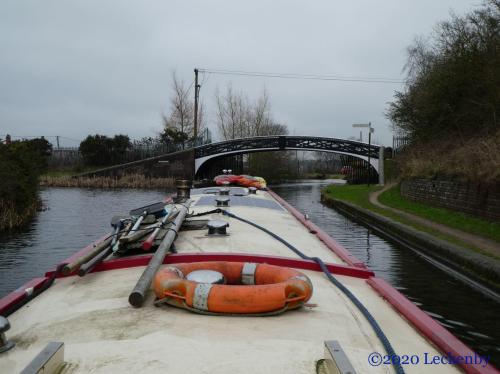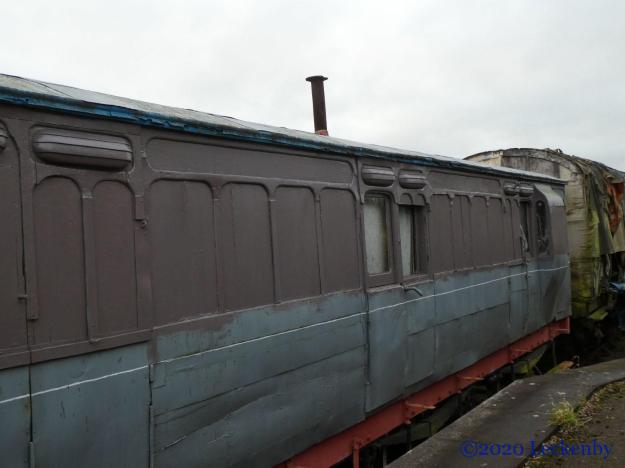Brownhills Services to Anglesey Basin

At sometime either last night or this morning we were joined by a third boat. The scum around Oleanna had been moving somewhat which suggested boat movement. After a slow start to the day we moved back to the water point, topped up our water, emptied yellow water and Tilly had her pooh box cleaned out, we were all ready to move onwards.

After half a mile of scummy cruising we arrived at Catshill Junction, it would be silly to go to the right without taking the detour up to Anglesey Basin first. So we veered left and skirted round the other side of Brownhills.

At Ogley Junction we passed what may one day be the restored Lichfield Canal which would join the Coventry Canal to the BCN at Huddlesford Junction.

Most probably not the first boaters to do this, but there was only one thing to eat whilst cruising today and Tesco had come up trumps, Curlywurlys! We’re sure they have shrunk since 1970 when they were first brought out. The internet was trawled for information, one chap collects the wrappers which in 1970 didn’t have to show the weight. Is it just that as you grow bigger everything gets smaller? Or have they shrunk? Certainly the adverts with Terry Scott must have had larger ones made to make him look like a young lad. A couple of years after they were first released the caramel recipe was changed to make it softer so that the chocolate didn’t fall off so easily. Maybe at this time they made the ladder of caramel have smaller holes, therefore making the bar smaller? Sadly they will be reducing their size soon so that they only contain 100 calories per bar.

Anyhow we enjoyed chewing our way along the Crulywyrley canal especially those extra 18 calories!

Fountains were out cutting back the hedges along the towpath, as the chap turned his mini tractor round we hung back, just incase he didn’t quite judge it right and ended up in the canal. Then under Watling Street, we always wonder how many times the A5 crosses the canal system.

Next we bobbed under the M6 Toll. Nearly at the end of the arm two old coal shoots still sit along side the canal, now redundant but once would have been filling boats from the local mines. Round a bend and up ahead we could see the bank leading up to the Chasewater Reservoir. Neither of us had thought of it being so high, but there it was towering above the canal.

We’d been warned that a chain had been put across the very end here. Before the chain two or maybe three boats could moor here side by side, but now only a short amount of hard edge is available. We winded and backed in for a closer look. On the northern side people have obviously pulled in, there is a ring at the stern and a bald patch in the scrub at around about the right position for most bows.

Mick hopped off with a spike, pulled us in with the centre rope. At last! somewhere that looked really rather great! Sideways trees, friendly cover (even if it is a touch spikey) and trees! What’s not to like? Well the amount of woofers! She came for a walk with me then left me to my own devices. Woohoo Bunnies too!!!


Tilly was occupied for quite sometime, the number of woofers didn’t seem to bother her, but after about an hour and a half she made a dash back to the boat. This then gave us the opportunity to go and have a nosy at the reservoir.

Chasewater Reservoir was built in 1797 as a feeder to the canal and the 160 miles of the BCN. In 1799 the eastern dam burst releasing a flood that headed downstream towards Shenstone after a summer storm had caused the reservoir to overtop and erode the bank. By 1800 the dam had been rebuilt, much stronger with a limestone lining.

In 1848 the feeder canal was made navigable due to the coal deposits in the area. In 1849 a colliery was opened right below the dam, would this be allowed today? The colliery only lasted to 1857 as it proved hard to contend with the local geology, but other collieries opened in the area and remained working into the 20th Century.

A railway was built to link the collieries, this is now Chasewater Railway, which is run as a heritage railway.

We walked along the banks, the reservoir now caters for leisure activities with sailing, water skiing and wakeboarding. Of course nobody was out on the water today, just plenty of walkers and bird watchers.


At Chasewater Railway we were able to have a quick look around before it all shut up shop for the day, no trains running. Several Pacer trains sat on the lines, presumably recent acquisitions, along with much older rolling stock, some in great need of some TLC.

0 locks, 2.94 miles, 2 lefts, 1 wind, M6, A5, 10th in the queue, 1 appointment, 1 full water tank, 1 empty wee tank, 1 clean pooh box, 2 curlywurlys, 118 calories, 2.5 hrs shore leave, 2 coal shoots, 4.4 billion litres of water, 1 very windy evening.

You wondered about the A5 Watling Street crossing the canal. The Waterway Routes Grand Union Canal (North) Bowcam DVD includes this commentary in the section between Gayton Junction and Norton Junction.
Bridge twenty two carries the modern A5 road over the canal as it follows the route of the Roman Watling Street. Running from London to Holyhead the A-five crosses canals fifteen times including once at an aqueduct, with even more crossings if you include closed canals. Three of those crossings are in this chapter, at bridge twenty six south of Weedon, at bridge twenty two we’ve just passed, and at bridge eleven below Buckby Top Lock, with a fourth crossing just beyond Norton Junction at Bridge Five on the Leicester Section of the Grand Union Canal.
Thank you Paul, I thought you’d know.
Here’s another question Paul: is the A5 Bridge 5 combination unique on the waterways or is there a similar combination anywhere else (for example A1 Bridge1) ?
Mick